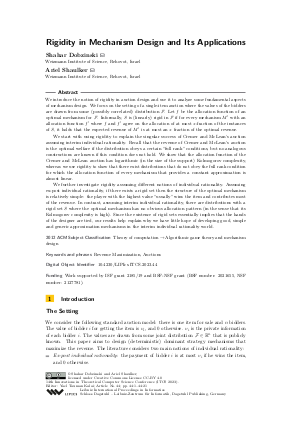Rigidity in Mechanism Design and Its Applications
Authors Shahar Dobzinski, Ariel Shaulker
-
Part of:
Volume:
14th Innovations in Theoretical Computer Science Conference (ITCS 2023)
Part of: Series: Leibniz International Proceedings in Informatics (LIPIcs)
Part of: Conference: Innovations in Theoretical Computer Science Conference (ITCS) - License:
 Creative Commons Attribution 4.0 International license
Creative Commons Attribution 4.0 International license
- Publication Date: 2023-02-01
File

PDF
LIPIcs.ITCS.2023.44.pdf
- Filesize: 0.72 MB
- 21 pages
Document Identifiers
Subject Classification
ACM Subject Classification
- Theory of computation → Algorithmic game theory and mechanism design
Keywords
- Revenue Maximization
- Auctions
Metrics
- Access Statistics
-
Total Accesses (updated on a weekly basis)
0Document
0Metadata
Abstract
We introduce the notion of rigidity in auction design and use it to analyze some fundamental aspects of mechanism design. We focus on the setting of a single-item auction where the values of the bidders are drawn from some (possibly correlated) distribution F. Let f be the allocation function of an optimal mechanism for F. Informally, S is (linearly) rigid in F if for every mechanism M' with an allocation function f' where f and f' agree on the allocation of at most x-fraction of the instances of S, it holds that the expected revenue of M' is at most an x fraction of the optimal revenue. We start with using rigidity to explain the singular success of Cremer and McLean’s auction assuming interim individual rationality. Recall that the revenue of Cremer and McLean’s auction is the optimal welfare if the distribution obeys a certain "full rank" conditions, but no analogous constructions are known if this condition does not hold. We show that the allocation function of the Cremer and McLean auction has logarithmic (in the size of the support) Kolmogorov complexity, whereas we use rigidity to show that there exist distributions that do not obey the full rank condition for which the allocation function of every mechanism that provides a constant approximation is almost linear. We further investigate rigidity assuming different notions of individual rationality. Assuming ex-post individual rationality, if there exists a rigid set then the structure of the optimal mechanism is relatively simple: the player with the highest value "usually" wins the item and contributes most of the revenue. In contrast, assuming interim individual rationality, there are distributions with a rigid set S where the optimal mechanism has no obvious allocation pattern (in the sense that its Kolmogorov complexity is high). Since the existence of rigid sets essentially implies that the hands of the designer are tied, our results help explain why we have little hope of developing good, simple and generic approximation mechanisms in the interim individual rationality world.
Cite As Get BibTex
Shahar Dobzinski and Ariel Shaulker. Rigidity in Mechanism Design and Its Applications. In 14th Innovations in Theoretical Computer Science Conference (ITCS 2023). Leibniz International Proceedings in Informatics (LIPIcs), Volume 251, pp. 44:1-44:21, Schloss Dagstuhl – Leibniz-Zentrum für Informatik (2023)
https://doi.org/10.4230/LIPIcs.ITCS.2023.44
BibTex
@InProceedings{dobzinski_et_al:LIPIcs.ITCS.2023.44,
author = {Dobzinski, Shahar and Shaulker, Ariel},
title = {{Rigidity in Mechanism Design and Its Applications}},
booktitle = {14th Innovations in Theoretical Computer Science Conference (ITCS 2023)},
pages = {44:1--44:21},
series = {Leibniz International Proceedings in Informatics (LIPIcs)},
ISBN = {978-3-95977-263-1},
ISSN = {1868-8969},
year = {2023},
volume = {251},
editor = {Tauman Kalai, Yael},
publisher = {Schloss Dagstuhl -- Leibniz-Zentrum f{\"u}r Informatik},
address = {Dagstuhl, Germany},
URL = {https://drops.dagstuhl.de/entities/document/10.4230/LIPIcs.ITCS.2023.44},
URN = {urn:nbn:de:0030-drops-175479},
doi = {10.4230/LIPIcs.ITCS.2023.44},
annote = {Keywords: Revenue Maximization, Auctions}
}
Author Details
Funding
Work supported by ISF grant 2185/19 and BSF-NSF grant (BSF number: 2021655, NSF number: 2127781).
References
-
Michael Albert, Vincent Conitzer, and Giuseppe Lopomo. Maximizing revenue with limited correlation: The cost of ex-post incentive compatibility. In Proceedings of the Thirtieth AAAI Conference on Artificial Intelligence, AAAI'16, pages 376-382. AAAI Press, 2016.

- Shuchi Chawla, Hu Fu, and Anna Karlin. Approximate revenue maximization in interdependent value settings. In Proceedings of the Fifteenth ACM Conference on Economics and Computation, EC '14, pages 277-294, New York, NY, USA, 2014. Association for Computing Machinery. URL: https://doi.org/10.1145/2600057.2602858.
-
Xue Chen, Guangda Hu, Pinyan Lu, and Lei Wang. On the approximation ratio of k-lookahead auction. In International Workshop on Internet and Network Economics, pages 61-71. Springer, 2011.

- Jacques Crémer and Richard P. McLean. Optimal selling strategies under uncertainty for a discriminating monopolist when demands are interdependent. Econometrica, 53(2):345-361, 1985. URL: http://www.jstor.org/stable/1911240.
- Jacques Crémer and Richard P. McLean. Full extraction of the surplus in bayesian and dominant strategy auctions. Econometrica, 56(6):1247-1257, 1988. URL: http://www.jstor.org/stable/1913096.
- Shahar Dobzinski, Hu Fu, and Robert D. Kleinberg. Optimal auctions with correlated bidders are easy. In Proceedings of the Forty-Third Annual ACM Symposium on Theory of Computing, STOC '11, pages 129-138, 2011. URL: https://doi.org/10.1145/1993636.1993655.
- Shahar Dobzinski and Nitzan Uziely. Revenue loss in shrinking markets. In Proceedings of the 2018 ACM Conference on Economics and Computation, EC '18, pages 431-442, New York, NY, USA, 2018. Association for Computing Machinery. URL: https://doi.org/10.1145/3219166.3219196.
- Ido Feldman and Ron Lavi. Optimal dsic auctions for correlated private values: Ex-post vs. ex-interim IR. SSRN Electronic Journal, 2021. URL: https://doi.org/10.2139/ssrn.3973665.
- Hu Fu, Christopher Liaw, Pinyan Lu, and Zhihao Gavin Tang. The value of information concealment. In Artur Czumaj, editor, Proceedings of the Twenty-Ninth Annual ACM-SIAM Symposium on Discrete Algorithms, SODA 2018, New Orleans, LA, USA, January 7-10, 2018, pages 2533-2544. SIAM, 2018. URL: https://doi.org/10.1137/1.9781611975031.162.
-
Ming Li, Paul Vitányi, et al. An introduction to Kolmogorov complexity and its applications, volume 3. Springer, 2008.

- Roger B. Myerson. Optimal auction design. Mathematics of Operations Research, 6(1):58-73, 1981. URL: http://www.jstor.org/stable/3689266.
- Christos H. Papadimitriou and George Pierrakos. On optimal single-item auctions. In Proceedings of the Forty-Third Annual ACM Symposium on Theory of Computing, STOC '11, pages 119-128, New York, NY, USA, 2011. Association for Computing Machinery. URL: https://doi.org/10.1145/1993636.1993654.
- Amir Ronen. On approximating optimal auctions. In Proceedings of the 3rd ACM Conference on Electronic Commerce, EC '01, pages 11-17. Association for Computing Machinery, 2001. URL: https://doi.org/10.1145/501158.501160.
